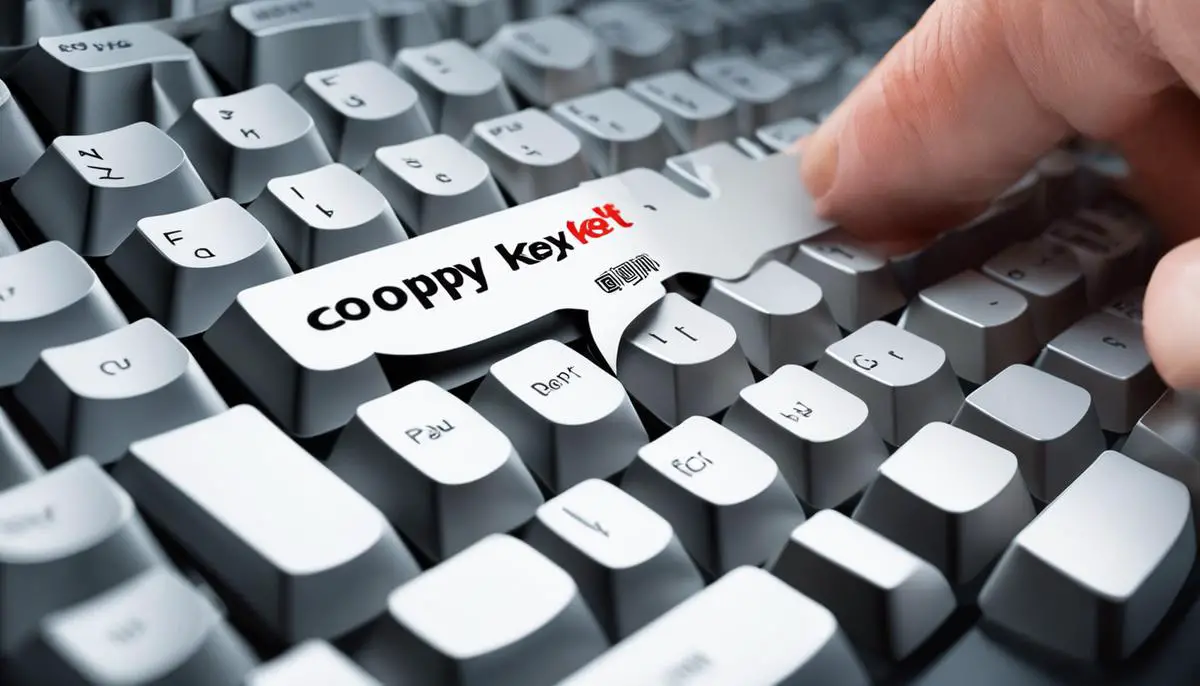Navigating the realm of digital creation and communication, mastering keyboard shortcuts becomes invaluable for increasing productivity. These simple combinations of keystrokes unleash a powerful mechanism beneath our fingertips, turning tasks that usually involve several mouse clicks into immediate actions. This essay will delve into the intricate world of keyboard shortcuts, focusing particularly on aspects such as ‘Copy’ and ‘Paste’. We will learn what these shortcuts are, their intrinsic functionality, and how they contribute to enhancing work efficiency. Furthermore, we will put a spotlight on how these shortcuts work across different software platforms and even operating systems.
Understanding Keyboard Shortcuts
Keyboard Shortcuts: The Underrated Efficiency Boosters
In the modern digital world, where every millisecond counts, increasing productivity and efficiency is crucial. Enter keyboard shortcuts – an unassuming yet revolutionary way to turbocharge your everyday computer tasks. This article underscores what keyboard shortcuts are, their utilization, and how they pile up to boost productivity.
Keyboard shortcuts, sometimes referred to as hotkeys, are a specific combination of keys on a keyboard that activate certain commands or functions, thereby making tasks faster and easier. Instead of clicking through numerous menus to perform a task, a keyboard shortcut triggers the action in a fraction of the time. They offer an abbreviated and direct path to executing commands, which traditionally could take multiple mouse clicks and menu navigations.
Most computer users are familiar with basic keyboard shortcuts such as “Ctrl+C” to copy and “Ctrl+V” to paste on Windows, or their Mac counterparts “Command+C” and “Command+V“. However, a galaxy of other shortcuts exists beyond these, which can considerably improve workflow and efficiency.
Consider the often-overlooked “Ctrl+S” shortcut for saving your work. The slight hand motion needed to execute this shortcut is exponentially quicker than manually navigating to the ‘File’ menu and clicking on ‘Save’. Consequently, keystrokes are saved, time is conserved, and productivity is enhanced.
Other examples include “Alt+Tab” for swiftly toggling between open programs or “Ctrl+Z” to undo an action, incredibly useful for any impromptu mistakes. For tech enthusiasts, coding wizards, and writers, the “Ctrl+F” function for finding specific words or phrases within a document or webpage is an absolute time-saver.
In terms of efficiency, the beauty of keyboard shortcuts lies within their simplicity and accessibility. They reduce the dependency on the mouse, which often demands more movements and clicks. The less time spent directing the cursor, the more time spent on executing and completing tasks.
The benefits of learning and using keyboard shortcuts transcend mere time-saving. They mitigate the risk of the repetitive strain injuries often linked with extensive mouse usage. Furthermore, they could give you the edge in a time-based competition, or easily make the difference in meeting a tight deadline.
Even though the initial process of adapting to keyboard shortcuts may feel somewhat difficult, the long-term benefits are substantial. A tech enthusiast’s dream is to automate and streamline processes. Keyboard shortcuts are a perfect embodiment of that ethos.
Therefore, take some time today to discover some new keyboard shortcuts and start accentuating productivity with these hidden gems of technology. After all, time is of the essence and efficiency is king in the digital realm. Not to mention, there is a certain geeky satisfaction in navigating the digital world mostly from the keyboard.
Rediscover the power beneath your fingertips – fall in love with your keyboard all over again.

Copy Shortcut Key Function
Delving into the Mechanics of the Much-Used Copy Shortcut Key Function
As we navigate the cyber-landscape of the 21st century, keyboard shortcuts continue to reign supreme as a method for streamlining tasks, boosting productivity, and enhancing the user experience. Many of us are already familiar with the simple examples, such as “Ctrl + C”, the copy shortcut key, but do we truly understand the full extent of the functionality offered by this particular command?
The copy shortcut key function or “Ctrl + C”, as it’s known to Windows users, or “Command + C” for Macintosh aficionados, presents a nearly universal method for swiftly replicating data, be it text, images, files, or folders. This crucial process is implemented through an intelligent use of your device’s clipboard. When you “copy”, your chosen content is duplicated and temporarily stored in an unseen area of your computer’s memory, the clipboard, waiting to be reproduced elsewhere.
In terms of applications, the copy function bridges varying facets of a device’s operation, integrating into the framework of many software applications and systems. Its use is not limited to just word processing or spreadsheet manipulation. Entire files and directories can also be duplicated using this simple command. It’s an invaluable tool in a coder’s toolbox, helping to replicate lines of script efficiently.
Making the most out of the copy function is not always about simple word replication, but about optimizing workflow. For example, repetitive use of source codes or commercial emails can be easily handled by copying and pasting them as templates. Moreover, graphic designers often resort to ‘copy’ functionalities to replicate styles or layers from one segment of a design to another.
As technology moves towards being more integrated, the boundaries of copy shortcut use have also expanded. Many modern applications, like Adobe Suite, and web browsers now support the copying of complex contents such as design elements, hyperlinks and formatted text, ensuring the original structure and format remain intact during the copying process.
Delving deeper, seemingly complex operations can be simplified to a large extent by mastering the copy function through the use of clipboard management tools. These digital aids enhance the basic functionalities offered by the system clipboard, archiving copied items for future use and allowing you to access a history of copied contents.
Overall, the utility of the copy function is far-reaching, cementing its position as one of the most versatile keyboard shortcuts. It has transformed from a simple duplicator to an advanced tool that optimizes workflow and enhances productivity across a variety of contemporary digital applications. So, remember when you press those two keys together, you’re not just saving a few clicks–you’re embracing technological advancement designed to streamline your digital life.

Paste Shortcut Key Function
Next, let’s delve into the paste function, a wonderful partner to the copy function, facilitating efficient information or data transfer within and even between different software applications.
The paste shortcut key functions akin to the retrieval system in a well-managed library. Once the copy key collects the required information, it catalogs it on the clipboard, from where the paste key collects it when needed.
In a nutshell, the ‘paste’ shortcut (ctrl+V on Windows, command+V on Mac) retrieves the latest ‘copied’ data from the clipboard memory, placing it wherever the cursor is currently blinking. This could be a text field, a document, an image editing software, or any application that supports the paste functionality.
Using paste facilitates rapid data transfer, effectively freeing users from repetitive typing or manual data entry tasks. Consider a scenario where a sentence or paragraph has to be replicated in multiple locations across a document. With the paste function, it becomes a cinch: simply copy once, then paste as needed. No needless typing, no extra effort.
Moreover, the combo of copy and paste extends even beyond text – it allows the same efficacy while dealing with files, images, and even folders. The concept remains: ‘copy’ duplicates, ‘paste’ places the duplicate. It’s a seamless integration, a perfect harmony that empowers users to handle digital tasks with unmatched alacrity and convenience.
Crucial to mention here is the potential of clipboard manager software – digital tools that enhance and extend the functions of the humble clipboard. They provide an ability to remember, organize, and retrieve multiple items that have been copied, pushing the productivity benefits of the copy-paste function far beyond its basic capabilities.
Furthermore, the concept of ‘paste special‘, found in many applications like Microsoft Word and Excel, allows for even more nuanced customization while pasting, such as maintaining original formatting, pasting only the values of copied cells, or even replicating the formulae or comments from copied data. This specialty doesn’t merely copy and paste; it does so selectively, adeptly, suiting the user’s precise requirements.
Hence, the paste function, coupled with the copy function, forms an essential pair of keyboard shortcuts that significantly reduce the need for repetitive tasks, optimize workflow, and thereby save precious time. In the current age where efficient use of time is a key determinant of productivity, mastering the copy-paste functions is a techno-enthusiast’s necessity, not an option. The digital realm beckons – are you ready to answer the call?

As technology continues to advance, the tools we utilize for productivity must keep pace. Keyboard shortcuts, particularly the ‘Copy’ and ‘Paste’ functions, exemplify these indispensable tools, spanning an array of softwares and platforms. Understanding their mechanisms, as well as their cross-platform applicability, allows us to increase efficiency and streamline our digital endeavors. Armed with this knowledge, we can fully engage the digital landscape, maneuvering through tasks with the simple press of a few keys.
